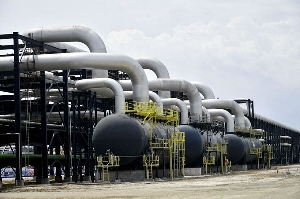- Home - News
- TWI News | TV
- Polls
- Year In Review
- News Archive
- Crime & Punishment
- Politics
- Regional
- Editorial
- Health
- Ghanaians Abroad
- Tabloid
- Africa
- Religion
- Election 2020
- Coronavirus
- News Videos | TV
- Photo Archives
- News Headlines
- Press Release
Opinions of Saturday, 8 July 2017
Columnist: Moses Antwi
Asunafo South needs starch factory not rice factory
Throughout the years, farmers in Brong/Ahafo region most especially the Asunafo North and Asunafo South have been contributing their quota towards food production in the country. In fact, their agricultural production towards the Gross Domestic Product (GDP) is remarkable and appreciable.
It was no coincidence that the planting for food and jobs policy by his Excellency Nana Addo Dankwa Akuffo Addo was launched in Goaso, the capital of Asunafo North Municipality. This is as a result of the fertile land this part of the country is blessed with.
Over the years, farmers in this part of the country apart from Cocoa have been cultivating different kinds of crops, notable among them are plantain, cassava, maize, Tomatoes and other Leguminous plants, although not on a large scale but their effort normally ensures constant supply of these food products throughout the year.
Even though the weather paten does not permit farming all year round, Farmers from this part of the country uses man made irrigation methods to support their crop production during the dry season.
In fact, throughout Ghana Asunafo district is one of the leading districts in production of cocoa, cassava, plantain and the rest.
The main problem in these farmers are facing is access to market for the farm produce, this is because the market is normally based on Kumasi-Accra-Tema and because of distance farmers normally suffers during their bumper harvests leading to post harvest losses.
Traders from these cities normally take advantage of the situation to buy the farm product at cheap prices because there are no alternative means of storing the products for future use or processing the produce to last long for the farmers thereby making farming unattractive for the young and energetic ones living the old and the weak to take farming as their occupation.
This situation has compelled most of the abled bodied men to migrate to the urban and semi urban centers to seek for non-existing white color jobs hence the need to do something to arrest this situation.
Is on this not that, the people of this district were very happy when the “planting for food and Jobs” policy of His excellency Nana Addo Dankwa Akuffo Addo was launched not in any part of the country but in Goaso. We the people of Asunafo embraced this policy with both hands and believe this is a step in the right direction.
We viewed it as a challenge to step up production to ensure abundant food supply throughout the year and hence serving as a source of employment to the teaming youth of this district.
This brings to mind the suitable factory under the “one district-one factory” policy to be located in this very district looking the traditional farming techniques and the traditional farm products in this district which can make life easy for the people whose major occupation is farming.
In locating an industry, our economic knowledge gives us some factors to consider among them is close to the source of Raw Material, labour force, power supply, market, infrastructure social amenities and the rest. We believe starch factory will have all these needs taking care of in the district.
Raw material is the main problem for most Ghanaian production companies. Cassava is one of the main and traditional produce from farmers in this area as compared to rice. On the average Five out of Six farmers in the district has cassava farms on like rice where One out of Two hundred farmers has rice farms.
This means that if we locate Rice processing company in Asunafo South, the government is going to spend additional money to import raw materials from other part of the country to the district for processing and again spends huge sums of money to train the farmers in the techniques of rice farming which will make the cost of doing that business too high.
We believe it will be better for us to locate a factory that process one of our traditional cash crops in the district in order to make life easy for our hard working farmers.
In addition to this, the land in this part of the country supports cassava farming more than rice farming, so is not a mere coincidence that the farmers in the Asunafo Districts both north and south are very good when it comes to cassava farming.
The Adam Smith’s Theory of Absolute advantage advices policy makers as to what to do when it comes to critical situation like this.
In his book The Wealth of Nations, he stated and I quote” It is the maxim of every prudent master of a family, never to attempt to make at home what it will cost…more to make than to buy. The Taylor does not attempt to make his own shows, but buys them from the shoe maker…. What is prudence in the conduct of every private family, can scarce be folly in that of a great kingdom.
If a foreign country can supply us with a commodity cheaper than we ourselves can make it, better buy it of them with some part of the product of our own industry, employed in a way in which we have some advantage”.
When we bring this to our local economy we can confidently say we are better in cassava production as compared to rice production and therefore we should improve upon what we can do better and live the rice factory to other districts that are very good when it comes to rice production.
Again this will clearly show that we will enjoy a comparative cost advantage if we opt for starch factory.
Another important factor to be taking into consideration is locating a factory to the source of labor.
Starch production is labor intensive and requires the company to locate to the source of labor of which I am proud to say the teaming youth of this district will serve as a source of labor to the company.
According to Investopedia labor intensive refers to a process or industry that requires a large amount of labor to produce its goods or services.
The degree of labor intensity is typically measured in proportion to the amount of capital required to produce the goods or services; the higher the proportion of labor costs required, the more labor intensive the business.
This part of the country is blessed with abundant labor force both skilled and unskilled that is always looking forward to migrate to the urban centers to look for white color jobs. Locating this factory in this district will reduce rural urban migration.
Then again in the The Heckscher–Ohlin theorem of international trade. It states and I quote “a country will export goods that use its abundant factors intensively, and import goods that use its scarce factors intensively. In the two-factor case, it states: "A capital-abundant country will export the capital-intensive good, while the labor-abundant country will export the labor-intensive good."
When we bring this theory into our local economy, what our policy makers in the district should know is, because we have the labor force and the raw material, we should produce and sell what will make good use of these factors, not what will make good use of a product from other districts which will render our people poor and create jobs for other districts.
Another very important factor to be taking into consideration is the source of market for the finished goods of this factory. Asunafo South is located in a strategic position such that transporting the finish goods from the district to Sunyani-Kumasi-Accra will not be difficult because of good road networks. Apart from this the local economy can form as a very big market base for the company.











